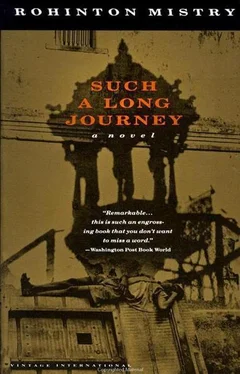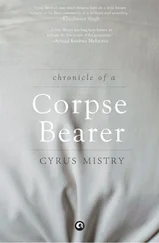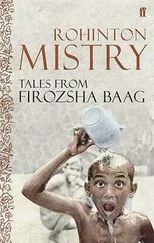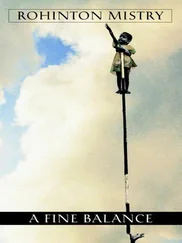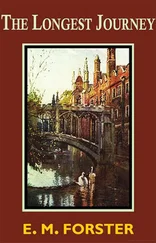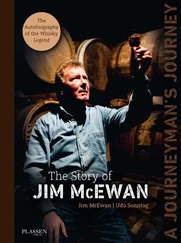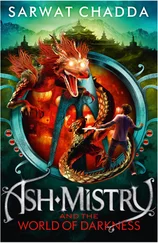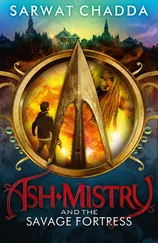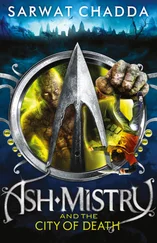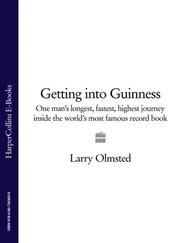Miss Kutpitia was delighted with the results. ‘Good, very good,’ she said. ‘What a nice, complete shape. Often it crumbles, and then it’s difficult to read. But you have done it so well.’ She placed the indeterminate mass on the telephone table and inspected it. ‘Come, you also look,’ she said. ‘But look at it without seeing it. That way it will take on different meanings. Look with the eyes you use when you dream.’
Dilnavaz tried, unsure of the instructions. ‘Reminds me of the Sister who brought Roshan home when she was sick.’
‘What?’ said Miss Kutpitia disbelievingly.
‘See, looks like the long white jhabbho the nuns wear.’
‘But would they want to hurt Roshan? They are good and godly people.’ She explained again. ‘Listen. If you use only your eyes, you will only see the things of this world. But we are dealing with forces from another world.’ They studied the alum again, silently, turning it this way and that.
‘Wait a minute, wait a minute,’ said Miss Kutpitia. ‘Yes, definitely. Stand here,’ she said, pulling Dilnavaz over to the other side. ‘Now what do you see?’
‘A hat? No. A house? A house without windows?’
Sorely disappointed with Dilnavaz’s hamstrung imagination, Miss Kutpitia dismissed the suggestions with the contempt they deserved, then guided her eyes with the benefit of her own expert vision. ‘Look, what is this? A tail. And this, this, this, and that? Four legs. And over there?’
‘Two upright ears!’ said Dilnavaz, excited, catching on at last, to her mentor’s relief. ‘And that, that’s a snout!’
‘Right!’ said Miss Kutpitia. ‘What does it all add up to?’
‘A four-legged animal?’
‘Of course. A dog, I think.’
‘A dog? Sending out a dark and evil force?’
‘You are not remembering what I said before.’ Miss Kutpitia was impatient. ‘I said the alum shape will give us a clue. That does not mean it will show the culprit. Someone who owns a dog could be the one we are looking for.’
Dilnavaz clutched her face with both hands. ‘O my God!’
‘Now what is it?’
‘Mr. Rabadi! He has a white Pomeranian! He was—!’
‘Calm down. First of all, does he have a reason?’
‘Yes, yes! He and Gustad have been fighting all the time, since the time of the big dog. Tiger, who used to do his chhee-chhee in Gustad’s flowers. And now the small dog also barks at him. Then there was trouble with newspapers, and he thinks my Darius is after his daughter. Rabadi really hates us!’
Miss Kutpitia picked up the crucial shape. ‘You know what you have to do next.’
A fragrance was in the air near the compound wall. ‘Where is it coming from?’ asked Gustad. The artist was fixing up his pictures. Some people had the annoying habit of touching the wall when they performed their obeisances. This had never bothered him in the past: during his years of wandering and drawing, he had learned that impermanence was the one significant certainty governing his work. Whenever the vicissitudes and vagaries of street life randomly dispossessed him of his crayoned creations, forcing him to repaint or move on, he was able to do so cheerfully. If short-panted, knobbly-kneed policemen did not stamp out his drawings with regulation black-sandalled feet, then eventually they became one with the rain and wind. And it was all the same to him.
But of late, something had changed, and he became very protective of his work. ‘Hallo, sir. Not seen you for many days,’ he said, putting down the crayon. ‘Lots of new pictures are complete.’
‘Beautiful.’ Gustad sniffed the air again. ‘Such a nice smell.’
‘It’s coming from Laxmi,’ said the artist, and Gustad walked towards the goddess of wealth. Someone had stuck an agarbatti in a pavement crack next to the picture. The incense stick was down to the final inch, its vital end glowing a bright orange. Frail wisps of grey-white smoke rose gently, floated towards Laxmi’s face, then vanished in the evening air. Gustad enjoyed the delicate fragrance. As the agarbatti burnt itself out, a length of ash dangled momentarily before falling in a sprinkle around the stub.
‘The wall is getting more and more popular,’ said Gustad. ‘But what about money, you are getting enough?’
‘Oh yes,’ said the artist. ‘This is a very good location.’ He showed off his new clothes. ‘Terylene pant — latest fashion, bell-bottoms, with seven belt loops. And Tery-Cotton shirt, drip-dry.’ He tugged at the collar to display the label on the inside. But his feet were still bare. ‘I went to Carona, Bata, Regal Footwear. Tried lots of different-different styles. Shoes, sandals, chappals, but they all pinch and hurt. Barefoot is the best.’ Then he led Gustad to his most recent artwork: Gautama Buddha in Lotus Position under the Bodhi Tree; Christ with Disciples at the Last Supper; Karttikeya, God of Valour; Haji Ali Dargah, the beautiful mosque in the sea; Church of Mount Mary; Daniel in the Lions’ Den; Sai Baba; Manasa, the Serpent-Goddess; Saint Francis Talking to the Birds; Krishna with Flute and Radha Holding Flowers; the Ascension; and finally, Dustoor Kookadaru and Dustoor Meherji Rana.
The artist was far from his usual reticent self; he confided that he was going to save up to buy new painting supplies: ‘From now on, no more crayons. All pictures in oil and enamel only. Completely permanent. Nothing will spoil them.’ Then he introduced Gustad to brief hagiographies of saints such as Haji Ali, who had died while on pilgrimage to Mecca. The casket containing his mortal remains floated miraculously across the Arabian Sea, back to Bombay, till it came to rest on a rocky bed not far from shore. Devotees constructed his tomb and a mosque on the very spot, as well as a causeway to the mainland which could be walked at low tide.
Then there was Mount Mary, another place of miracles. A band of frightened fishermen, caught in a violent storm, were certain they would drown. But the Blessed Virgin Mary appeared and assured them they would be safe, for she would watch over them. In return, they were to build a church atop a hill in Bandra, and place in it a statue which would wash ashore at the foot of that hill. The fishermen reached dry land safely. Next morning, when the seas grew calm, a statue of Mother Mary with the Infant Jesus in her arms floated ashore at the very beach.
The artist unfolded one story after another, and Gustad listened, engrossed. What a wealth of knowledge, he thought. And apart from the way the wall had been transformed into a clean place, there was such a sense of goodness about it, about the holy pictures.
When it got too dark to see, Gustad went into the compound. Inspector Bamji’s Landmaster rolled in. ‘ Arré bossie! Amazing thing you have done, really. In one shot all the fucking pissers gone. No more goo-mooter, no more stink. Just like a bloody miracle, bossie.’
‘With so many saints and prophets on the wall, one miracle should be easy.’
‘Too good, bossie, too good!’ said Bamji. ‘You have made it pisser-proof. But you know, I don’t understand the maader chod mentality of our neighbours. Can you believe it? Some of them (I won’t say names) are grumbling — that why should all perjaat gods be on a Parsi Zarathosti building’s wall. I’m telling you, sawdust in their brains.’
‘I think I can guess who they are.’
‘Oh, forget it, bossie. Not worth thinking about. Instead of being happy that smell is gone, nuisance gone, mosquitoes gone, saala maader chods find something else to cry about.’
‘Anyway,’ said Gustad, ‘the artist has drawn Zarathost Saheb. And also Meherji Rana and Dustoorji Kookadaru.’
Читать дальше
